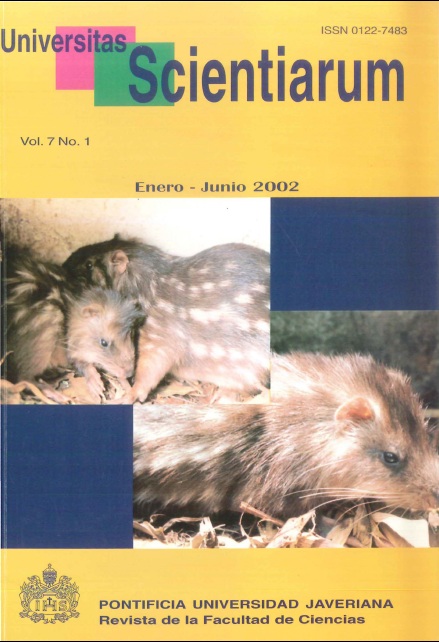Abstract
The activity of dung beetles (Scarabaeidae) associated with woolly monkey (Lagothrix lagothricha) dung, assecondary seed dispersal agents, was studied in Tinigua National Park, Meta, Colombia. From 62 dung sampleswe estimated a mean range of 30-33 small seeds, 3-5 medium seeds and 0-1 large seeds by fragment. The meanduration from the deposition of each dung fragment to dung beetle arrival was 3,2 hours. The means of horizontal17Universítas Scientiarum Vol. 7, N° 1: 17-29and vertical seed postdispersal distance was variable depending on dung beetle type: For the ball roller: 60,6 cm(±1 ,7 cm) and 0,8 cm (±o,2 cm) respectively; for fragment roller: 10,2 cm(± 0,2 cm) and 5,5 cm (±o,6cm) and forthe burrower's vertical remotion was O, 1 cm without horizontal remotion. The longest horizontal removal distan cewas presented by a ball roller.beetle Cantlwn luteicol/is (272 cm). Of 74 individual dung beetles observed, 37were catalogued as piece rollers, 27 as ball rollers and 10 as strict burrowers. The mean arrival times to dungpieces was smaller for rollers than for burrowers. We observed selection of dung material, as well as cooperationand competition between species and within species by dung beetles. The remotion distance of seeds resultedinversely proportional with its size. These observations suggest that not only the initial dispersa! by woolly monkeysand the posterior distribution of dung in the moment of deposition play an important role linked to the success orfailure of the seeds, but the relocation by the dung beetles also contributed to the general dispersa! process.
Univ. Sci. is registered under a Creative Commons Attribution 4.0 International Public License. Thus, this work may be reproduced, distributed, and publicly shared in digital format, as long as the names of the authors and Pontificia Universidad Javeriana are acknowledged. Others are allowed to quote, adapt, transform, auto-archive, republish, and create based on this material, for any purpose (even commercial ones), provided the authorship is duly acknowledged, a link to the original work is provided, and it is specified if changes have been made. Pontificia Universidad Javeriana does not hold the rights of published works and the authors are solely responsible for the contents of their works; they keep the moral, intellectual, privacy, and publicity rights. Approving the intervention of the work (review, copy-editing, translation, layout) and the following outreach, are granted through an use license and not through an assignment of rights. This means the journal and Pontificia Universidad Javeriana cannot be held responsible for any ethical malpractice by the authors. As a consequence of the protection granted by the use license, the journal is not required to publish recantations or modify information already published, unless the errata stems from the editorial management process. Publishing contents in this journal does not generate royalties for contributors.



